Mastering Nutcracker Drinks: A Complete Guide


Intro
Nutcracker drinks remain a vibrant aspect of celebratory culture, particularly in regions where festive gatherings abound. Originating from Caribbean traditions, these colorful beverages have captivated many with their unique flavors and joyful presentation. This guide aims to demystify the intricate process of crafting nutcracker drinks, making it accessible for both novices and seasoned mixologists. We will explore their roots, core components, and a variety of preparation methods. Furthermore, this article will provide tips on enhancing flavors and making these drinks suitable for a multitude of occasions.
The allure of nutcracker drinks is not just in their taste but also in their creativity. The visual appeal paired with unique flavors can elevate any gathering. The versatility of these beverages allows them to shine at barbeques, family reunions, or winter festivities. The preparation techniques often involve an infusion of various spirits and flavors, creating a balance that is refreshing yet robust. This comprehensive guide will ensure you possess the knowledge and tools necessary to create your own nutcracker drinks effectively.
Understanding Nutcracker Drinks
In the realm of mixology, nutcracker drinks hold a unique position due to their vibrant flavors and versatile nature. They are often associated with festive occasions and have the ability to cater to a wide range of tastes. Understanding nutcracker drinks is crucial for creating beverages that are not only enjoyable but also memorable. This section will delve into the essential components that define nutcracker drinks, as well as their historical background, which provides a deeper appreciation of their cultural significance.
Defining Nutcracker Drinks
Nutcracker drinks are commonly known for their rich, fruity flavors, and are typically based on a combination of various liquors, juices, and mixers. These drinks tend to be served in large quantities, making them suitable for social gatherings where sharing is a part of the experience.
Key characteristics of nutcracker drinks include:
- Bold Flavors: The blend of ingredients creates a drink that is both refreshing and invigorating.
- Colorful Presentation: Often, the drinks are visually appealing, with bright colors that enhance their festive nature.
- Customizable Recipes: The base ingredients can easily be adjusted to suit personal preferences or seasonal availability.
Understanding these elements is fundamental for anyone looking to master the art of making nutcracker drinks, as it sets the foundation for both classic and innovative concoctions.
Historical Context and Origin
The origin of nutcracker drinks can be traced back to certain cultural practices that emphasize celebration and camaraderie. While the exact roots may be difficult to pinpoint, it is believed that these drinks were first popularized in the United States, emerging during the vibrant social scenes of urban parties. Traditionally, nutcracker drinks were made for substantial gatherings, often during the winter holidays when warmth and comfort are cherished.
In different regions, the recipes and ingredients have evolved. For example, some versions include spices that reflect local tastes or utilize regional fruits. This adaptability has allowed nutcracker drinks to become a staple in various celebrations beyond their initial contexts.
The historical significance of nutcracker drinks is evident in the way they bring people together, fostering social interactions. Whether enjoyed at holiday gatherings, summer picnics, or cocktail parties, their presence often enhances the overall experience. Understanding their background enriches one's appreciation for the drink and opens the door to numerous possibilities in crafting personalized recipes.
"Nutcracker drinks are not simply beverages; they are a celebration of community and culture, reflecting the spirit of the occasion in every sip."
In summary, understanding nutcracker drinks is essential not only for creating delicious beverages but also for recognizing their cultural and historical significance. This foundation serves as a launchpad for exploring various ingredients, preparation methods, and unique recipes that honor the essence of these delightful drinks.
Core Ingredients of Nutcracker Drinks
The core ingredients of Nutcracker drinks serve as the foundation for creating these delightful concoctions. Understanding these ingredients is crucial as it determines the flavor profile, texture, and overall experience of the drink. A careful selection of key components can elevate a simple drink into a memorable one, aligning with personal tastes and the occasion at hand. The balance among spirits, mixers, and enhancements is essential for crafting a well-rounded beverage.
Essential Liquors and Spirits
In crafting a Nutcracker drink, the choice of liquors and spirits plays a vital role. Traditional Nutcracker drinks often include a base of vodka or rum, which provides a neutral canvas for other flavors. Vodka is favored for its smoothness, allowing the other ingredients to shine through. Rum, particularly tropical varieties, adds depth and complexity, making it a good choice for summer variations.
Moreover, the selection of flavored spirits, such as coconut rum or spiced rum, can significantly alter the drink’s character. The potency of the alcohol also affects the overall taste. Using higher proof liquors can create a stronger experience but may need careful balancing with mixers to prevent overpowering flavors.
When selecting spirits, consider quality over quantity. Higher quality liquors typically yield smoother drinks and can enhance the overall experience. Experimenting with different types can reveal unique flavor combinations that delight the palate.
Fruit Juices and Mixers
Fruit juices and mixers bring liveliness and balance to Nutcracker drinks. Freshly squeezed juices like lime, orange, or pineapple, are preferred for their vibrant flavors. They not only add sweetness but also acidity that brightens the overall taste. Lime juice is often essential, providing a zesty kick that complements the spirits well.
In addition to juices, soda or tonic water can serve as mixers to dilute the alcohol while adding effervescence. For example, lemon-lime soda or ginger ale can enhance flavors without overwhelming them. The choice of mixers should aim to balance sweetness, tartness, and carbonation, creating a multi-dimensional drink experience.
Other Flavor Enhancers
Beyond the base spirits and juices, other flavor enhancers play a crucial role in elevating Nutcracker drinks. These may include herbs, spices, and syrups. Fresh mint leaves can impart a refreshing quality, while a dash of grenadine can introduce a sweet, fruity note.
Spices such as cinnamon or nutmeg might be added for warmth, particularly in seasonal variations of Nutcracker drinks. Simple syrups made from raw sugar or flavored with fruits can provide sweetness without the roughness of granulated sugar.
Overall, determining where to invest your efforts when selecting ingredients can lead to remarkable results. Consider experimenting with proportions and combinations to achieve the balance that resonates best with your taste.
The quality of your ingredients directly influences the success of your Nutcracker drink.
By understanding and thoughtfully selecting these core ingredients, you will lay a solid foundation for your Nutcracker creations, whether they be classic recipes or unique variations crafted to delight.
Preparation Techniques
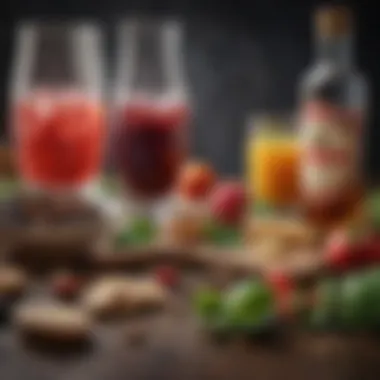
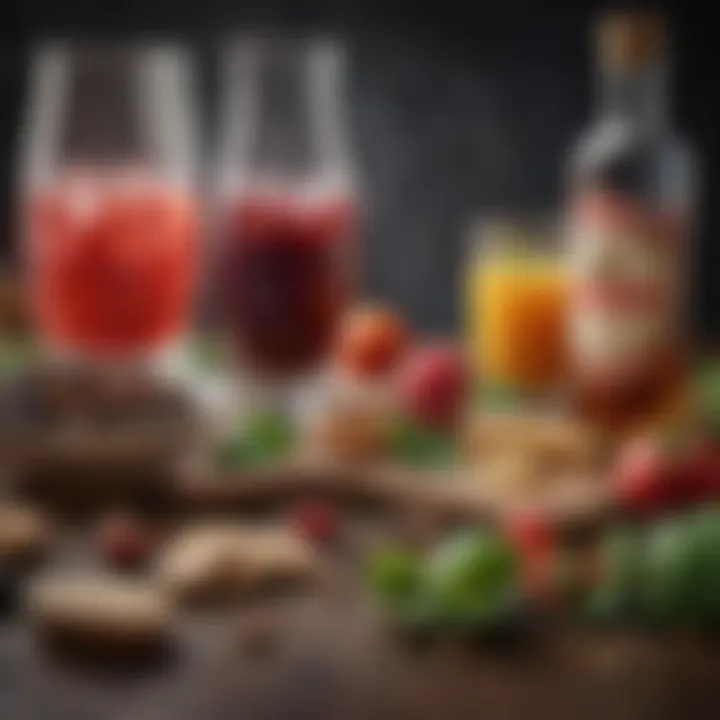
Understanding the right preparation techniques for nutcracker drinks is essential for both novice and experienced beverage creators. The manner in which the ingredients are combined significantly influences the final flavor and presentation of the drink. Whether you desire a refreshing cocktail for a summer gathering or a warm beverage for the winter holidays, mastering these techniques can enhance your mixing skills and elevate the drinking experience.
Basic Mixing Methods
At the core of any nutcracker drink is the method used to mix the components together. Here are some basic methods:
- Stirring: This is a common method, particularly for drinks that contain delicate ingredients like fruit juices or bitters. To stir, place all the ingredients in a mixing glass with ice and use a spoon to combine them gently. This method helps maintain a smooth texture.
- Shaking: Shaking is employed for drinks that include ingredients that are not easily mixed, such as thick juices or syrups. In this method, all ingredients are placed in a cocktail shaker filled with ice. Shaking allows for a more vigorous blending, resulting in a frothy and refreshing drink.
- Muddling: This technique is common when using fruits or herbs. By pressing down on the ingredients with a muddler, you release their essential oils and flavors. It is an important step, particularly in drinks that prioritize fresh flavors.
Each method has its place and contributes to the overall profile of the nutcracker drink, providing varying levels of texture and flavor diffusion.
Shaking vs. Stirring
The debate between shaking and stirring can be critical depending on the desired outcomes. Each method imparts a different character to the drink:
- Shaking: When you shake a cocktail, you introduce air into the mixture, which can create a frothy or bubbly texture. This is particularly beneficial for nutcracker drinks that aim for a light and refreshing quality.
- Stirring: In contrast, stirring promotes a silky and unagitated mixture. This is better suited for cocktails that contain clear spirits or require a more refined texture. Ultimately, the choice hinges on the overall flavor profile you intend to achieve.
A good rule of thumb is to call for shaking when using fruit juices or cream, and opting for stirring when the cocktail relies heavily on spirits.
Layering Drinks for Aesthetics
Layering is a visual technique that helps create stunning presentations, often seen in cocktails. It involves pouring ingredients in a specific order so that they do not mix fully. To achieve a layered drink:
- Choose Drinks with Different Densities: Start with the heaviest liquid at the bottom. For the nutcracker, you might use a syrup as your base.
- Pour Slowly and Steadily: Use the back of a spoon to gently pour each subsequent layer on top of the previous one. This method prevents the liquids from blending, maintaining a distinct visual appearance.
- Consider Color Contrast: Use colorful ingredients to enhance the display. Bright fruit juices can create a pleasing contrast, making the drink visually appealing.
Layering drinks not only enhances aesthetics but also influences the drinking experience as each layer can be sipped separately for an evolving flavor profile.
Mastering these preparation techniques is crucial for achieving the desired outcomes in nutcracker drinks. With practice, these skills will become second nature, allowing for creativity and personalization in every cocktail you make.
Popular Nutcracker Drink Recipes
The section on popular Nutcracker drink recipes is fundamental to understanding how to craft these beverages. Recipes offer both a framework and a starting point for experimentation. Each recipe has unique ingredients, techniques, and flavor profiles, which can inspire both novice and seasoned mixologists. These drinks often showcase creativity and adaptability, appealing to a range of tastes. Additionally, having a selection of established recipes can help ease the process for those new to making Nutcracker drinks.
Classic Nutcracker Recipe
The classic Nutcracker drink serves as the cornerstone of this beverage category. It embodies the blend of flavors that define Nutcracker drinks. A traditional recipe usually consists of vodka, honey, and fresh fruit juices such as orange or pineapple. The balance of sweetness and citrus adds depth and refreshment.
To prepare this drink, the following steps are taken:
- Ingredients: Gather one part vodka, half a part honey, and two parts of your preferred fruit juice.
- Mixing: In a shaker, combine the vodka and honey, stirring until the honey is dissolved.
- Shaking: Add ice and fruit juice, then shake vigorously.
- Serving: Strain the mixture into a glass filled with ice and garnish with a slice of fruit, like an orange or lemon.
This recipe is appreciated for its simplicity and versatility. It can easily be adjusted for sweetness or acidity based on personal preference.
Tropical Variation
The tropical variation introduces a delightful twist while maintaining the essence of the Nutcracker. This variant typically incorporates coconut rum, fresh mango juice, and lime for a refreshing experience. It is perfect for summer gatherings or beach-themed parties.
To make this drink:
- Ingredients: Use one part coconut rum, one part mango juice, and a splash of lime juice.
- Mixing: Combine all ingredients in a shaker with ice.
- Shaking: Shake well to mix everything together.
- Serving: Pour into a chilled glass and add a lime wedge for garnish.
This recipe showcases how Nutcracker drinks can draw from tropical influences, making them suitable for various occasions.
Spicy Nutcracker Twist
Adding a spicy element to Nutcracker drinks can enhance their flavor profiles significantly. The spicy Nutcracker twist usually features jalapeño-infused tequila and citrus. This recipe balances heat with the refreshing notes found in traditional variations.
To prepare, follow these steps:
- Ingredients: Combine one part jalapeño-infused tequila, half a part lime juice, and a splash of agave syrup.
- Mixing: In a shaker, blend the ingredients with ice.
- Shaking: Shake it well to ensure everything is mixed.
- Serving: Strain into a glass with ice and garnish with a jalapeño slice for an extra kick.
This recipe offers a surprising twist and invites adventurous drinkers to appreciate a different side of Nutcracker drinks.
Non-Alcoholic Version
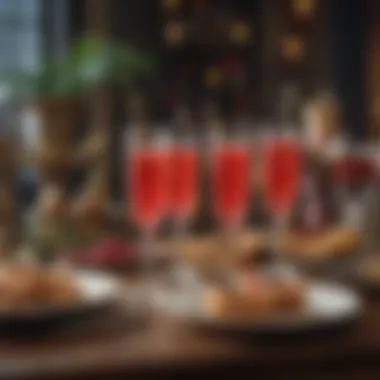
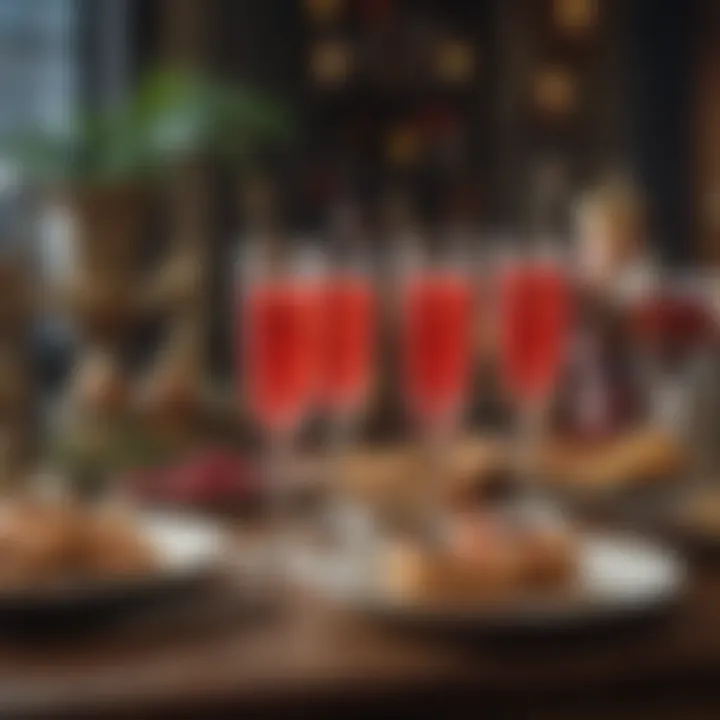
Not all occasions require alcohol, and a non-alcoholic Nutcracker drink caters to a wider audience. This version maintains the festive vibe while providing an enjoyable beverage for everyone.
To create a non-alcoholic Nutcracker drink:
- Ingredients: Combine two parts sparkling water, one part fresh apple juice, and a splash of cranberry juice for color.
- Mixing: Simply mix the juices in a glass.
- Serving: Pour the mixture over ice and top with sparkling water. Garnish with apple slices or berries.
This option is ideal for family gatherings or events where guests may prefer non-alcoholic drink options. The flavors remain vibrant and appealing.
Each Nutcracker drink recipe presented serves to enhance your understanding of various methods and ingredient combinations. Experimentation leads to discovery, making the process of crafting these beverages both rewarding and enjoyable.
Serving Suggestions
Serving suggestions for nutcracker drinks are crucial for enhancing the overall drinking experience. The way a drink is presented can significantly influence both its visual appeal and the perception of taste. This section focuses on key elements, such as choosing the right glassware and employing effective garnishing techniques, which can elevate your nutcracker drinks from merely enjoyable to memorable.
Choosing Appropriate Glassware
Selecting the right glassware plays a vital role in how nutcracker drinks are experienced. Each type of drink typically has a corresponding glass type that complements its characteristics. For a classic nutcracker drink, a sturdy cup or a tall glass can enhance the presentation. The clarity of the glass also contributes to the visual appeal, allowing the colors of the drink to shine through.
Here are some considerations for choosing glassware:
- Type of Drink: Consider the specific flavor profile or theme of the nutcracker drink.
- Size: Ensure the glass can accommodate all ingredients while leaving room for ice or mixers.
- Temperature: Use glass that maintains temperature, such as insulated or double-walled options.
Choosing a glass that fits these criteria can make a difference in how the drink is received by your guests. It shows thoughtfulness and attention to detail that can impress those enjoying your creations.
Garnishing Techniques
Garnishes are not just about aesthetics; they also add an extra layer of flavor and complexity to nutcracker drinks. A well-chosen garnish can enhance the drink's appeal and can be an expression of creativity. Various techniques exist to ensure garnishes contribute positively to the drink experience.
- Utilizing Fresh Ingredients: Fresh herbs, fruits, or even edible flowers can bring vibrancy to a drink. For example, a sprig of mint or a slice of citrus can enhance both flavor and aroma.
- Consider Texture: Garnishes can add different textures. A sugared rim on the glass or a sprinkle of spice can create interesting mouthfeel contrasts.
- Color Coordination: Choose garnishes that complement the drink’s color scheme to create a visually appealing presentation.
Good garnishing elevates not just the look but also the overall flavor!
When executed properly, garnishing can transform a simple nutcracker drink into an eye-catching centerpiece.
Occasions for Nutcracker Drinks
Nutcracker drinks are not only about flavor; they are also about context. The right occasion can elevate the experience of enjoying these beverages. In this section, we will explore how to integrate nutcracker drinks into various social settings, enhancing enjoyment and creating memorable moments. Each occasion presents its unique style, which can affect the choice of ingredients and presentation, thus highlighting the versatility of nutcracker drinks.
Holiday Gatherings
The holiday season is synonymous with celebration. Nutcracker drinks play a significant role in these gatherings as they offer a festive way to toast with family and friends. The rich flavors and colorful presentations can brighten any holiday table. During occasions like Christmas or New Year’s Eve, these drinks can set a joyful tone.
Considerations:
- Theme Harmony: Choose ingredients that resonate with holiday themes, such as cinnamon, nutmeg, or cranberry.
- Batch Preparation: Preparing drinks in large quantities simplifies service and allows for more time with guests.
- Garnishing: Festive garnishes like sprigs of rosemary or slices of citrus can enhance visual appeal.
Set the mood with holiday classics or creative interpretations. The key is to create an ambiance that encourages togetherness and celebration.
Cocktail Parties
Cocktail parties are opportunities for sophistication and socializing. Nutcracker drinks can impress guests, making them a perfect fit for such events. The variety allows for customization, catering to different preferences and tastes.
Considerations:
- Signature Drink: Creating a signature nutcracker drink can become a talking point.
- Small Bites: Pairing drinks with small appetizers enhances flavor experiences. For example, a spicy nutcracker drink can balance well with meat skewers.
- Interactive Elements: Encourage guests to mix their own versions, fostering engagement.
Whether it’s an intimate gathering or a larger celebration, nutcracker drinks serve as a versatile element that can adapt to the theme and feel of the party.
Summer Celebrations
Summer gatherings require a refreshing approach. Nutcracker drinks can be adjusted with lighter, fruit-based ingredients, making them ideal for outdoor events like barbecues or garden parties.
Considerations:
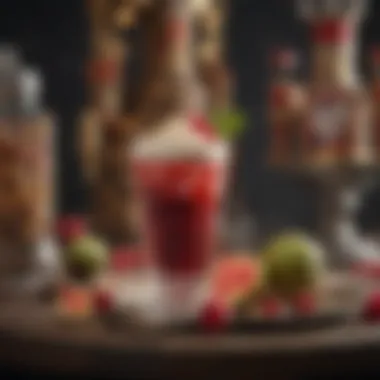

- Chill Factor: Serve drinks ice-cold to combat heat while staying refreshing.
- Fruit Enhancements: Utilize seasonal fruits like watermelon or pineapple for vibrant and cooling flavors.
- Non-Alcoholic Options: Provide alternatives for guests who prefer non-alcoholic beverages, ensuring inclusivity.
In this context, the emphasis is on enjoyable, refreshing sips that complement the festive summer atmosphere.
Tips for Enhancing Flavor Profiles
Understanding how to enhance the flavor profiles of nutcracker drinks is paramount for a truly memorable experience. Flavor is not just a single note; it’s a harmonious blend of various elements that come together to create something unique. By mastering these tips, one can elevate their nutcracker preparations and cater to a more refined palate. It’s about finding the right balance and knowing how to incorporate ingredients thoughtfully.
Balancing Sweetness and Acidity
Sweetness and acidity are two fundamental tastes that need to be balanced for a satisfying drink. If a drink tips too far towards sweetness, it can become cloying, overshadowing the other flavors. Conversely, excessive acidity can create an unpleasant sharpness, making the drink less enjoyable. Here are key components to keep in mind when achieving this balance:
- Taste as You Go: Always sample your mixture while preparing. This allows you to adjust sweetness or acidity instantly.
- Use Fresh Juices: Freshly squeezed juices, such as lemon or lime, provide a bright acidity that can cut through sweetness effectively.
- Experiment with Sweeteners: Not all sweeteners are alike. Consider using agave syrup or honey, which can have distinct flavor notes compared to regular sugar.
By paying attention to these factors, you can create a drink that is well-rounded and appealing to a broader audience.
"Balancing flavors is key to crafting exceptional cocktails; it’s where the magic happens."
Incorporating Fresh Ingredients
Fresh ingredients have the power to transform a nutcracker drink, adding vibrancy and complexity. When using fresh components, flavors become more pronounced and the overall presentation improves. Here are some ways to incorporate fresh ingredients effectively:
- Use Seasonal Produce: Incorporating what is in season can enhance the drink's flavor profile. For example, using ripe berries in summer or citrus fruits in winter can create seasonal relevance.
- Herbs and Spices: Fresh herbs like mint or basil can introduce a refreshing element, while spices like cinnamon can add warmth.
- Garnishing with Fresh Elements: A sprig of fresh mint or a slice of citrus not only brightens the appearance but also subtly influences the aroma and flavor as the drink is consumed.
Opting for fresh rather than packaged will likely yield better results in flavor and presentation. This consideration elevates the overall drinking experience and engages the senses more fully.
Nutcracker Drink Variations Around the World
Understanding the global adaptations of nutcracker drinks plays a significant role in appreciating their versatility and cultural significance. This section examines how regional preferences influence the ingredients, flavors, and preparation methods across different areas. The ability to adapt this drink not only showcases creative interpretations but also reflects the local ingredients available, traditions, and taste preferences. Whether it's a twist on the classic recipe or an entirely new creation, these variations offer explorations into unique flavor profiles.
Regional Adaptations in the US
In the United States, nutcracker drinks have evolved to reflect local tastes and traditions. Different regions have adopted distinct flavors, leading to various adaptations. For example:
- Northeast: In urban areas like New York, nutcracker drinks often incorporate tropical flavors such as passion fruit and mango. These ingredients are vibrant and popular in summer parties.
- South: The South often favors sweetness, leading to the incorporation of cola-based mixes or southern fruits like peach. Here, the drink becomes a sweet refreshment for warm evenings.
- West Coast: Areas like California may emphasize fresh, local produce. Ingredients like organic lemon juice or unique fruit blends such as guava are common.
Such adaptations highlight how regional influences can create diverse and interesting takes on nutcracker drinks. The process of localization not only enhances the flavor but also helps in connecting with the drinkers on a cultural level.
International Inspirations
Globally, nutcracker drinks draw inspirations from various cultures, resulting in each locale offering its unique spin:
- Caribbean Variations: Often, rum is the spirit of choice, combined with fresh coconut water and tropical fruits. These drinks evoke a sense of vacation and celebration.
- Latin America: In countries like Mexico, nutcracker drinks can feature spicy elements, often integrating chili with pineapple juice, making for a fiery blend. This combination not only enhances flavor but also adds a distinctive kick that resonates with local cuisine.
- European Twists: European countries may introduce herbal liqueurs or bitters to the nutcracker mix. These elements add complexity and depth, making the drink suitable for quieter gatherings or formal events.
By looking at these international inspirations, drink enthusiasts can find endless possibilities to innovate their own nutcracker recipes. Adapting to different regional ingredients and cultural elements not only enriches the drink but also fosters creativity in mixology.
The beauty of nutcracker drinks lies in their ability to transform, showcasing both tradition and innovation in flavors.
Exploring these variations opens doors to recipes that can please diverse palates. Understanding the rich history and developments behind these drinks ensures a more profound appreciation of the craft.
End
Understanding how to create nutcracker drinks is vital for those interested in mixology and culinary exploration. This article has provided a comprehensive overview of these unique beverages, emphasizing their diverse ingredients, preparation techniques, and suitable occasions.
Recap of Nutcracker Drink Essentials
To ensure a successful nutcracker drink, several key elements stand out:
- Core Ingredients: Familiarity with essential liquors such as rum or vodka and suitable mixers like fruit juices is fundamental.
- Preparation Techniques: Various methods, whether shaking, stirring, or layering, enhance the drink's overall presentation and flavor profile.
- Serving Suggestions: Choosing the right glassware and garnishing appropriately elevates the drinking experience.
- Variations and Experimentation: Nutcracker drinks can vary by region and culture, opening avenues for creativity and personalization.
By grasping these essentials, readers gain the tools needed for both traditional and innovative nutcracker drinks.
Encouragement for Experimentation
As we conclude, it is crucial to encourage readers to experiment with their nutcracker drink creations. Each ingredient can bring a different flavor, and altering the ratios can result in unique combinations.
- Try New Ingredients: Incorporating fresh herbs, spices, or alternative mixers might lead to new taste sensations.
- Adapt Recipes: Use the classic recipes as foundation but feel free to make them your own.
- Engage in Global Inspirations: Look to international nutcracker drink variations for ideas. Each culture may present its own take on flavors, providing a rich backdrop for your creativity.
"Creativity in drink-making opens doors to flavor discovery. Each nutcracker drink serves as a canvas for personal expression."
In light of this, remember: mixology is an art form. Your experimentation could lead to a drink that resonates with many. Embrace the process and delight in your findings.







